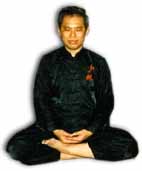CONTEMPLATION AND ZEN MEDITATION

Contemplation Meditation
Question 16
Please could you discuss the methods and objectives of contemplation practices as they relate to, or differ from, Zen meditation?
Matt
Answer
Contemplation meditation and Zen meditation are two important, different categories of meditation.
Many people mistakenly think that there is only one type of meditation, just as they mistakenly think that there is only one type of chi kung.
In fact, they are countless types of meditation, and countless types of chi kung, both ranging from the basic to the most profound.
The term “meditation” is not a suitable choice of words. It comes from the verb “meditate”, which means to think or intellectualize. But in many forms of meditation, including the ones we practice in our school, thinking or intellectualizing is exactly what one should avoid.
Personally, I find the phrase “training of mind” to be more exact. “Mind” may be replaced with “soul”, “spirit” or “consciousness” in some cultural or religions context.
In classical Chinese, the concept of meditation is described as “entering Zen”, “entering Tao” or “entering silence”. In modern context, it is “entering a chi kung state of mind”. But the term “meditation” has been established, so despite its short-comings, we still use it.
Then, why is the term “meditation” used? It originated from the spiritual cultivation of the early Christian fathers, which consisted of four processes, namely reading scriptures, praying to God, contemplating on God’s words, and reflecting on the Truth. This historical fact is important to those who erroneously think that meditation is non-Christian.
Later other forms of spiritual cultivation were introduced to the West from the East. While the internal approaches and techniques might be different, the external form was similar. Hence, the term “meditation” was used and became established.
Apart from Zen, there are two main categories of meditation for spiritual cultivation, namely concentration and contemplation.
In concentration meditation, the mind is trained to be one-pointed. In Christian meditation, this refers to the two processes of reading scriptures and praying to God until the soul is totally devoted to God.
In Islamic meditation, or muraqabah, this is dhikr, where devotees continuously repeat phrases to God until there is no other thoughts but God. In Buddhist meditation, it is called samatha where practitioners focus on one object until the mind becomes concentrated.
Having attained concentration of mind, contemplation begins where devotees contemplates on the Supreme. In Christian meditation, it refers to the two processes of contemplating on God’s words and reflecting the Truth.
In Islamic meditation, it is tafakkur, where devotees reflect on the universe and the Supreme. In Buddhist meditation, it is called vipassana where practitioners investigate into Reality.
Although the techniques may be different, both the approach and the ultimate aim is the same. The approach is having attained a one-pointed mind or focused soul, the aspirants expand their mind or soul transcendentally to attain a spiritual awakening or to return to God.
Zen meditation is different in its approach but the ultimate aim is the same. Instead of first concentrating the mind and then expanding to Universal Mind through concentration and contemplation, Zen aspirants aim directly at no-mind which is Universal Mind.
The underlying philosophy is as follows. Everything is originally Universal Mind, or described in some religions as there is nothing but God. But we mortals experience the undifferentiated Universal Mind as the phenomenal world because of thoughts. One way to return to Universal Mind or God is to tear down the countless thoughts, as in concentration and contemplation. This is referred to as a gradual path.
Another way, referred to as a sudden path, is to aim straight at no thoughts. When no thoughts arise, phenomena disappear and Universal Mind or the Supreme Reality naturally results.
This is what is meant by saying that nirvana and samsara are the same, the difference is a matter of spiritual perspective. In other words, it is the same Cosmic Reality, but when we have thoughts we perceive and experience the undifferentiated Cosmic Reality as countless entities in our phenomenal world.
In scientific context, everything is an undifferentiated spread of energy. But conceptualization transforms the undifferentiated energy into countless objects in our so-called objective world.
Hui Neng, the Sixth Patriarch, describes this Truth poetically. When one is unenlightened, he is a mortal; when he is enlightened he is Buddha.
At the mundane level, we employ the sudden path in our arts and daily life. Other people may have to practice chi kung for months before they can have a chi flow. We enter into a chi kung state of mind, and have a chi flow within a minute.
Other people have to practice appropriate exercises for months to have internal force. We enter Zen or Tao, consolidate our energy flow and experience internal force in fifteen minutes!
Other people have to concentrate their mind and contemplate on their problems for months, yet may not have a solution. We throw the problems into the Cosmos and within five minutes a solution appears.
Other people not exposed to our training will think we are boastful. But our students who have direct experience of the benefits know that we are merely stating the truth.

Zen Meditation
The above is reproduced from the thread 10 Questions to the Grandmaster about Zen in the Shaolin Wahnam Discussion Forum
LINKS
